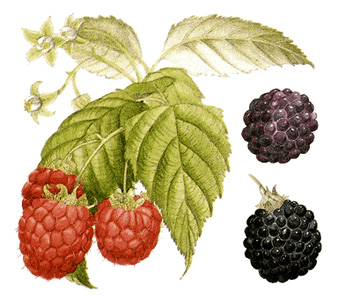Raspberry is a thorny bush that produces small, round, tasty fruit. Each fruit, also called a berry, consists of a cluster of cells, called drupelets, that look like tiny beads. Drupelets are partly hard and partly fleshy and grow around a core known as a receptacle. The receptacle remains on the bush after the fruit is picked. Most commercially grown raspberries are red, but some are black, purple, white, or yellow. Raspberries are eaten fresh or used to make jams and jellies. Frozen raspberries are also popular.

Raspberries grow best in cool regions of North America and Europe. The countries of Eastern Europe produce more than three-fourths of the world’s raspberries. In the United States, the leading raspberry-growing states are Oregon and Washington. In Canada, British Columbia ranks first in production.
Growing raspberries.
Growers begin new red raspberry bushes from raspberry suckers obtained from healthy plants. Suckers are underground shoots that grow from the roots of the plants. The suckers are raised in a nursery for one growing season and then transplanted outdoors. During the first growing season after they have been transplanted, the suckers produce only canes (stems) and branches. Fruit and flowers develop the following year.
Growers produce new black and purple raspberries by bending the tips of raspberry plants over and covering them with soil. The tips develop roots, which are transplanted the next season. The plants do not produce fruit until the second growing season after the roots have been transplanted. Most raspberry plants produce fruit for about six years. The bushes thrive in deep, fertile, well-drained soil.
Various training systems are used to grow raspberries. These systems ensure the proper development of the raspberry plants and allow growers to care for them easily. The three most common systems are the hedgerow, staked hill, and trellis systems. In the hedgerow system, raspberry bushes are planted in rows that are about 3 feet (0.9 meter) apart. Growers using the staked hill system plant the bushes in mounds about 6 feet (1.8 meters) apart. In the trellis system, plants grow on three to five wires that are attached to stakes. Raspberries are harvested by machine, or they are picked by hand.
Diseases and pests.
Raspberries are attacked by a number of diseases, including mosaic disease and other virus diseases, as well as the fungus diseases anthracnose and orange rust (see Fungal disease ; Mosaic disease ). Growers control these diseases by spraying the bushes with fungicides and by clearing patches of dead wood away from the plants. They also destroy the canes after the fruit has been harvested.
Raspberry plants are also attacked by such insects as the crown borer, the cane borer, the raspberry sawfly, and the rose chafer. Growers guard against these pests by spraying the bushes with insecticides.
